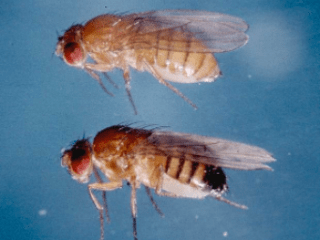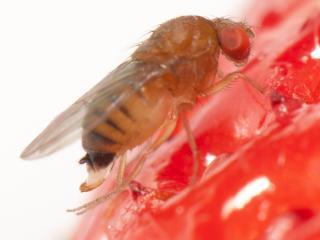
It is not the strongest of the species that survives, or the most intelligent ; it is the one most capable of change
Mots clés: Plasticité phénotypique, Biologie de l'invasion, Température, Drosophila

Phenotypic plasticity and adaptive responses to environmental change
My research work has allowed me to explore different aspects concerning the adaptive responses of organisms to environmental changes, mainly temperature, on the insect model and especially on Drosophila through a comparative approach. I was particularly interested in phenotypic plasticity which can be defined as the ability of a genotype to produce different phenotypes according to environmental conditions. Phenotypic plasticity is a phenomenon that can be generalized to all living organisms and that can be found in all species and for a wide variety of phenotypic traits.
The main questions addressed during my research are :
How to analyze the shapes of non-linear reaction norms? Do these reaction norms present genetic variability? How do these norms evolve between populations and between species? Do these comparisons provide arguments for adaptive phenotypic plasticity?
How will environmental variability (thermal fluctuation) impact the shape of response norms? What about environmental complexity (combination of several factors)?
What is the importance of phenotypic plasticity as a response mechanism to environmental perturbations?
On this issue, I am coordinating the ANR TRAPP project, which started on January 1, 2025 for 4 years and involves two LBBE teams (GEI and ECE), the CASPER unit of Anses in Lyon and the Institut de Génétique Humaine in Montpellier. Agriculture and vector control programs make intensive use of chemical insecticides to control insect pests and disease vectors. They represent a major selection pressure for insect populations.
Transgenerational plasticity (TGP) is a form of non-genetic inheritance in which a change in the phenotype of offspring is triggered by an environmental signal in the parental generation without involving genetic modification. The existence of the TGP process is no longer disputed, but many questions remain, notably concerning the molecular mechanisms of these intergenerational effects and the persistence of TGP over more than two generations. In this project, we propose to use the experimental power offered by Drosophila melanogaster, a model species in physiology, developmental biology and genetics, to explore TGP in response to insecticides. Molecular mechanisms linked to TGP, particularly epigenetics, will be studied. This species can also be considered a sentinel species, representative of insect species exposed to contaminants in most agroecosystems, such as the Drosophila sp. community and the related pest species D. suzukii, but observations can probably be generalized to other arthropods. The study of the transgenerational impacts of insecticides is still little taken into account in insecticide risk assessment.

Drosophila suzukii: a recent biological invasion and a major economic threat
For the past few years, my research activity has focused on a project concerning a very recent biological invasion event involving a fruit crop pest, Drosophila suzukii. At the fundamental level, we were first interested in the ecological factors that explain the invasive success of this species whose biology was poorly known. We showed that French larval parasitoids were unable to control D. suzukii populations because of its very high immune resistance capacity. We also showed that this species has a very wide range of wild host plants present throughout the year and we highlighted an interesting case of self-medication in D. suzukii. Moreover, our results suggest that if D. suzukii does not really have competitors on healthy fruits, it can undergo a strong larval competition with D. melanogaster on rotten fruits on which an oviposition avoidance behavior is observed. Current projects aim to use the recent and spectacular invasion of D. suzukii to better understand the mechanisms of adaptation to a new environment, in particular the role of phenotypic plasticity. Finally, some projects have also been developed to consider new control methods against this formidable crop pest.
Marie Panza's thesis, which I am co-supervising with Laurence Mouton (LBBE) and Vincent Foray (IRBI Tours), focuses on the resistance capacity of the crop pest Drosophila suzukii to a parasitoid recently introduced into France, Leptopilina japonica. To this end, we propose a three-part study: 1) To characterize the variation in resistance to L. japonica between invasive European populations of D. suzukii and look for potential trade-offs with fitness-related traits. 2) Test the influence of environment and microbiota on D. suzukii resistance to L. japonica. This part will focus on the effect of the nutrient environment and the heritable bacterium Wolbachia. 3) Identify the proximal factors underlying variation in resistance to L. japonica. This analysis will investigate the molecular mechanisms underlying intra-specific variation in D. suzukii, but also inter-specific variation between D. suzukii and another Drosophila species, D. melanogaster. From a fundamental point of view, this study will contribute to our understanding of the ultimate and proximal factors involved in host-parasitoid resistance variation. From an applied point of view, it will provide valuable results for the development of a biological control program against D. suzukii and the assessment of risks of resistance emergence. This project is being carried out in close collaboration with our colleagues in the Biological Control Research and Development team at ISA Sophia Antipolis.
Physiological basis of insect community responses to climate change
This collaborative project is led by Cameron Ghalambor (Professor) Norwegian University of Science and Technology, Norwayhttps://www.ntnu.edu/employees/cameron.ghalambor
The earth's climate is evolving rapidly, leading to observable changes in the abundance and geographical distribution of insects. These changing climatic conditions could lead to a global decline or, on the contrary, the growth of certain insect species. Insects play an important role in ecosystem functioning, crop pollination and disease transmission, so understanding the causes of these changes is an important issue for biodiversity, agriculture and human health. To date, our understanding of insect physiological responses to climate change is based mainly on thermodynamic and energetic responses to temperature. However, the integration of the combined effects of temperature on water loss and desiccation risk is important to consider. Insects are particularly vulnerable to desiccation due to their small size and limited water storage capacity. They lose water as the temperature rises across the surface of their cuticle and through high respiration rates.Research has shown that the thermal sensitivity of water loss and metabolism varies from species to species, but no study to date has attempted to systematically describe these patterns in insect groups and in climates varying in temperature and precipitation. We propose to fill this gap by investigating the thermal sensitivity of metabolic rate and water loss in insect species from different climates in Europe. We will combine these data with climate projection models to build new models for predicting how species will respond to future conditions.
Responsabilités
- Membre du Conseil Scientifique du CNRS depuis octobre 2023
- Coresponsable du Living Lab Anthares au sein du PEPR SOLU-BIOD depuis 2023
- Membre de la commission interdisciplinaire 50 ‘Gestion de la Recherche’– 2022-2025.
-
Membre de la Commission scientifique Sciences Exactes et Naturelles-4 (SEN-4) et de la Commission scientifique Sustainability du F.R.S.-FNRS depuis 2022.
Publications
Display of 31 to 60 publications on 116 in total
Back and forth Wolbachia transfers reveal efficient strains to control spotted wing drosophila populations
Journal of Applied Ecology . 55 ( 5 ) : 2408-2418
Journal article
see the publicationDevelopment of a PCR-RFLP assay to identify Drosophila melanogaster among field-collected larvae
Ecology and Evolution . 8 ( 20 ) : 10067 - 10074
DOI: 10.1002/ece3.4453
Journal article
see the publicationSterile insect technique and Wolbachia symbiosis as potential tools for the control of the invasive species Drosophila suzukii
Journal of Pest Science . 91 ( 2 ) : 489-503
Journal article
see the publicationPlasticité phénotypique et réponses adaptatives au changement climatique
L’adaptation au changement climatique . 978-2-271-09482-7 : 95-102
Book chapter
see the publicationTransposable Element Dynamics in an Invasive Species
Congrès National des Éléments Transposables (CNET 2018) .
Conference paper
see the publicationInfluence of extreme heat or cold stresses on body pigmentation of Drosophila melanogaster
Journal of Thermal Biology . 72 : 118 - 126
Journal article
see the publicationMicrobial warfare between competing Drosophila species shapes niche partition
International Conference on Ecological Sciences (Sfécologie 2018) . : 825 p.
Conference paper
see the publicationThe invasive pest Drosophila suzukii uses trans-generational medication to resist parasitoid attack
Scientific Reports . 7 ( 1 )
DOI: 10.1038/srep43696
Journal article
see the publicationDrosophila suzukii et la pourriture acide du raisin
Revue Française d'Oenologie . ( 285 ) : 31
Journal article
see the publicationManaging cold tolerance and quality of mass-produced Drosophila suzukii flies to facilitate the application of biocontrol through incompatible and sterile insect techniques
Third FAO–IAEA International Conference on Area-wide Management of Insect Pests .
Poster
see the publicationThe ecology of fly-bacteria-yeast symbiosis: laboratory interactions and their relevance to in-natura processes
Réunion REID .
Conference paper
see the publicationApproches expérimentales de l’étude de la Plasticité Phénotypique
Ecole thématique PLASPHEN .
Conference paper
see the publicationThe ecology of fly-bacteria-yeast symbiosis: no relevance of laboratory interactions to in-natura processes
Colloque Immunité des Invertébrés (Immuninv 2017) .
Conference paper
see the publicationInvasive Drosophila suzukii facilitates Drosophila melanogaster infestation and sour rot outbreaks in the vineyards
Royal Society Open Science . 4 ( 3 ) : np
DOI: 10.1098/rsos.170117
Journal article
see the publicationWhere and what to feed? Differential effects on fecundity and longevity in the invasive Drosophila suzukii
Basic and Applied Ecology . 19 : 56-66
Journal article
see the publicationEffects of daily fluctuating temperatures on the Drosophila–Leptopilina boulardi parasitoid association
Journal of Thermal Biology . 60 : 95 - 102
Journal article
see the publicationAll or nothing: Survival, reproduction and oxidative balance in Spotted Wing Drosophila (Drosophila suzukii) in response to cold
Journal of Insect Physiology . 89 : 28-36
Journal article
see the publicationIntroduced Drosophila subobscura populations perform better than native populations during an oviposition choice task due to increased fecundity but similar learning ability
Ecology and Evolution . 6 ( 6 ) : 1725 - 1736
DOI: 10.1002/ece3.2015
Journal article
see the publicationWolbachia in European Populations of the Invasive Pest Drosophila suzukii: Regional Variation in Infection Frequencies
PLoS ONE . 11 ( 1 ) : e0147766
Journal article
see the publicationDrosophila as models to understand the adaptive process during invasion
Biological Invasions . 18 ( 4 ) : 1089 - 1103
Journal article
see the publicationThe Wide Potential Trophic Niche of the Asiatic Fruit Fly Drosophila suzukii: The Key of Its Invasion Success in Temperate Europe?
PLoS ONE . 10 ( 11 ) : e0142785
Journal article
see the publicationWorldwide invasion by Drosophila suzukii : does being the "cousin" of a model organism really help setting up biological control ? hopes, disenchantments and new perspectives
Revue d'Écologie . 70
Journal article
see the publicationInvasion biology of spotted wing Drosophila (Drosophila suzukii): a global perspective and future priorities
Journal of Pest Science . 88 ( 3 ) : 469 - 494
Journal article
see the publicationThe rapid northward shift of the range margin of a Mediterranean parasitoid insect (Hymenoptera) associated with regional climate warming
Journal of Biogeography . 41 ( 7 ) : 1379 - 1389
DOI: 10.1111/jbi.12314
Journal article
see the publicationInvasive host for invasive pest: when the Asiatic cherry fly ( Drosophila suzukii ) meets the American black cherry ( Prunus serotina ) in Europe
Agricultural and Forest Entomology . 16 ( 3 ) : 251 - 259
DOI: 10.1111/afe.12052
Journal article
see the publicationDrosophila suzukii, vers une lutte biologique contre ce ravageur des fruits rouges
Phytoma . 660 : 34-38
Journal article
see the publicationResistance of Drosophila suzukii to the larval parasitoids Leptopilina heterotoma and Asobara japonica is related to haemocyte load
Physiological Entomology . 38 ( 1 ) : 45 - 53
DOI: 10.1111/phen.12002
Journal article
see the publicationDoes cold tolerance plasticity correlate with the thermal environment and metabolic profiles of a parasitoid wasp ?
Comparative Biochemistry and Physiology - Part A: Molecular and Integrative Physiology . 164 : 77-83
Journal article
see the publicationOccurrence of arrhenotoky and thelytoky in a parasitic wasp Venturia canescens(Hymenoptera: Ichneumonidae): Effect of endosymbionts or existence of twodistinct reproductive modes?
European Journal of Entomology . 110 : 103-107
Journal article
see the publicationAbility of European parasitoids (Hymenoptera) to control a new invasive Asiatic pest, Drosophila suzukii
Biological Control . 63 ( 1 ) : 40 - 47
Journal article
see the publication